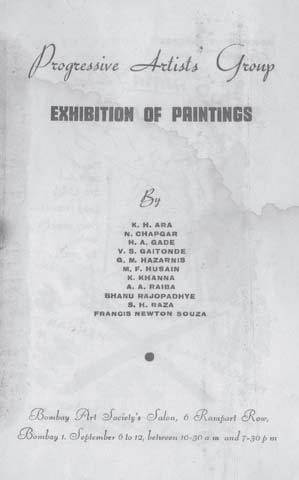The 1940s were a decade of political urgency and artistic transformation in India—especially in Bombay, where anti-colonial movements, Marxist cultural activism, and encounters with European émigrés sparked a radical new visual language. As the Quit India Movement mobilized students and artists alike, figures like P.C. Joshi and Mulk Raj Anand rallied for an art that was politically engaged and socially conscious. The Progressive Writers’ Association, the Calcutta Group, and the Indian People’s Theatre Association (IPTA) all shaped a cultural climate where art and resistance were deeply intertwined.
Jewish émigrés fleeing fascism—Walter Langhammer, Rudolf von Leyden, and Emanuel Schlesinger—became influential mentors to a generation of Indian modernists, including F.N. Souza. Within this charged landscape, Souza’s dissenting voice took shape—fueled by expulsion, exile, and a refusal to conform, he emerged as one of the most provocative artists of the Progressive Artists’ Group (PAG), co-founded in 1947, the year of Indian independence.
1940s
- The Quit India Movement (1942) galvanized students, artists, and intellectuals, making Bombay a hub of anti-colonial resistance.
- The Communist Party of India (CPI), under P.C. Joshi actively supported the arts as a tool for political mobilization.
- The Progressive Writers’ Association (PWA) (originally named Anti-Fascist Writers Association), founded in London (1935) and Calcutta (1936), shaped the city’s cultural discourse.
- Mulk Raj Anand, a leading figure, advocated for a socially engaged aesthetic in literature and art, deeply influencing Souza and his contemporaries.
- Jewish émigrés fleeing Nazi persecution—such as Walter Langhammer, Rudolf von Leyden, and Emanuel Schlesinger—became mentors and patrons of Bombay’s modernists, introducing them to Expressionism, Cubism, and European modernist ideas.
Against this backdrop, F.N. Souza emerged as a radical voice in Indian modernism.
1943
- Bengal Famine (Engineered) led to a slew of political activity and a surge in writing
- Formation of the Calcutta Group, India’s second artist collective with a manifesto to make “international art”.
- The Communist Party of India (CPI) encourages art as a political tool, led by P.C. Joshi, Anil De Silva and Others
1944–1945
- P.C. Joshi and I.P.T.A. organizes two Calcutta Group exhibitions in Bombay, introducing modernist ideas that shape Souza and his peers.
- K.H. Ara, later a PAG member, works as a studio assistant for the Calcutta Group shows (Lalit Kala Contemporary 31).
- Jewish émigrés Walter Langhammer, Rudolf von Leyden, and Emanuel Schlesinger become key mentors and patrons, supporting Souza, Husain, and Raza.
1945
- Souza participates in the Quit India Movement.
- Expulsion from J.J. School of Art for participating in anti-colonial activities. Spends months in Goa. His first solo show was in December, in Bombay.
- Rudy Von Leyden reviews Calcutta Group’s exhibition in The Times of India in 1945.

1946
- Second solo show at Silverfish Club, Bombay.
1947
- July 1947: Bhanu Athaiya enrolls at J.J. School of Art; she later becomes the only female member of PAG.
- September 1947 – Rathin Maitra, a founding member of the Calcutta Group, holds a solo show at the Bombay Art Society
- December 1947 – Three of the (Calcutta) Group members including the present writer (Prodosh Dasgupta) were in Bombay. They were invited by Rudolph von Leyden, one of the three European patrons of the younger artists of Bombay, to a small conference in the Artists' Aid Centre to help form a similar progressive group of artists there. (Prodosh Dasgupta, "The Calcutta Group – Its Aims & Objectives," Lalit Kala Contemporary 31)
- 1947 is marked as the formation year of the PAG in various archives
That the formation of PAG coincided with the Independence of India was symbolic, but coincidental.
(F.N. Souza, Patriot Magazine, February 12, 1984)
1948
- Third and fourth Solo shows by Souza at the Bombay Art Society ( Souza: The Artist, His Loves, & His Times, Ribeiro)
1949
- Smaller PAG exhibitions are held in Bombay, including one at the French Ambassador’s residence, referenced in letters by Bhanu Athaiya.
- The inaugural exhibitions of the PAG in Baroda in February and Bombay in July (Zehra Jumabhoy and Boon Hui Tan. The Progressive Revolution. Modern Art for a New India)

Invitations to the February and July 1949 exhibitions by the Progressive Artists' Group
- Final solo show by Souza at the Bombay Art Society Salon before leaving for the U.K. (‘Souza in the Forties, Dhoomimal Catalogue, 1983)

Rudolf and Nena von Leyden’s farewell party for Francis Newton. Front from left: PAG = M.F. Husain, S.K. Bakre, H.A. Gade, K.H. Ara, F.N. Souza, S.H. Raza with writer Mulk Raj Anand. Back: Käthe Langhammer), Rudolf von Leyden with his wife Nena (centre), Walter Langhammer (2nd right), Ebrahim Alkazi (theatre pioneer, 1st right back), Bombay 1949. (© Private Archive James von Leyden, Lewes; All Rights Reserved)
- July 22, 1949 – Souza departs for London
1950
- A year after Souza’s departure to London, PAG & The Calcutta Group hold a historic joint exhibition in Calcutta

- Featuring F.N. Souza, K.H. Ara, M.F. Husain, S.H. Raza, H.A. Gade, S.K. Bakre, and Gobardhan Ash’s avant-garde 'Avatar' series, the show marks a significant moment in Indian modernism.
![]()
Gobardhan Ash's 'Avatar' Series
1953
- The Final Exhibitions of the Progressives Artists Group

- New members Krishen Khanna, Gaitonde, and Akbar Padamsee join PAG
- Bhanu Rajopadhye Athaiya exhibits in this show as the only woman member of PAG.
- Another PAG show held in 1953 featuring V.S. Gaitonde, A.A. Raiba, K.H. Ara, G.M. Hazarnis, Krishen Khanna, M.F. Husain, H.A. Gade, and Mohan Samant.

Credits: Mohant Samant, Ranjit Hoskote et al
The Fading Away of the Group
- Though PAG fades away, its impact on modern Indian art remains unparalleled.
Souza’s work continues to shape Indian modernism, bridging influences across continents.